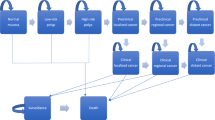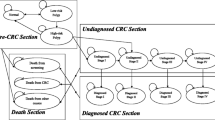Abstract
Background
Screening of populations at risk for colorectal cancer (CRC) allows the detection and successful treatment of tumours and their precursor polyps. The current UK CRC screening programme is faecal occult blood testing (FOBT), despite evidence from modelling studies to suggest that more cost-effective technologies exist.
Objective
To assess the cost effectiveness of CT colonography (CTC) for colorectal cancer screening from the perspective of the UK NHS.
Methods
A state-transition Markov model was constructed to estimate lifetime costs and health outcomes of a cohort of individuals screened at age 60–69 years using four different CRC screening technologies: FOBT, flexible sigmoidoscopy, optical colonoscopy and CTC.
Results
CTC screening offered every 10 years was cost saving compared with the current UK programme of biennial FOBT screening. This strategy also yielded greater health benefits (QALYs and life-years) than biennial FOBT screening. The model fit observed CRC epidemiology data well and was robust to changes in underlying parameter values. CTC remained cost effective under a range of assumptions in the univariate sensitivity analysis. However, in the probabilistic sensitivity analysis, CTC dominated FOBT in only 5.9% of simulations and was cost effective at a threshold of £30 000 per QALY gained in 48% of simulations.
Conclusions
CTC has the potential to provide a cost-effective option for CRC screening in the UK NHS and may be cost saving compared with the current programme of biennial FOBT. Further analysis is required to assess the impact of introducing CTC to the UK CRC screening programme on the NHS budget and capacity.










Similar content being viewed by others
References
Office of National Statistics. Cancer statistics: registrations of cancer diagnosed in 2005, England [series MB1, no. 36]. Newport: Office for National Statistics, 2008 [online]. Available from URL: http://www.statistics.gov.uk/down loads/theme_health/MB1_36/MB1_No36_2005.pdf [Accessed 2010 Mar 22]
Office of National Statistics. Mortality statistics: cause [series DH2, no. 32]. Newport: Office for National Statistics, 2006 [online]. Available from URL: http://www.statistics.gov.uk/downloads/theme_health/Dh2_32/DH2_No32_2005.pdf [Accessed 2010 Mar 22]
Trueman P, Lowson K, Bending M, et al. Bowel cancer services: costs and benefits. York: York Health Economics Consortium, 2007
Jackman RJ, Mayo CW. The adenoma-carcinoma sequence in cancer of the colon. Surg Gynecol Obstet 1951; 93(3): 327–30
Muto T, Bussey HJ, Morson BC. The evolution ofcancer of the colon and rectum. Cancer 1975; 36(6): 2251–70
Winawer SJ, Zauber AG, Ho MN, et al. Prevention of colorectal cancer by colonoscopic polypectomy. The National Polyp Study Workgroup. N Engl J Med 1993; 329(27): 1977–81
National Institute for Health and Clinical Excellence. Improving outcomes in colorectal cancers: a manual update. London: NICE, 2004
Burling D, Halligan S, Slater A, et al. Potentially serious adverse events at CT colonography in symptomatic patients: national survey of the United Kingdom. Radiology 2006; 239(2): 464–71
Pickhardt PJ. Incidence of colonic perforation at CT colon-ography: review of existing data and implications for screening ofasymptomatic adults. Radiology 2006; 239(2): 313–6
Thomeer M, Bielen D, Vanbeckevoort D, et al. Patient acceptance for CT colonography: what is the real issue? Eur Radiol 2002; 12(6): 1410–5
Pickhardt PJ, Choi JR, Hwang I, et al. Computed tomographic virtual colonoscopy to screen for colorectal neoplasia in asymptomatic adults. N Engl J Med 2003; 349(23): 2191–200
Zalis ME, Perumpillichira JJ, Magee C, et al. Tagging-based, electronically cleansed CT colonography: evaluation of patient comfort and image readability. Radiology 2006; 239(1): 149–59
Tappenden P, Chilcott J, Eggington S, et al. Option appraisal of population-based colorectal cancer screening programmes in England. Gut 2007; 56(5): 677–84
Tappenden P, Eggington S, Nixon R, et al. Colorectal cancer screening options appraisal: cost-effectiveness, cost-utility and resource impact of alternative screening options for colorectal cancer. Report to the English Bowel Cancer Screening Working Group. Sheffield: University of Sheffield, School of Health and Related Research, 2004 Sep
Hardcastle JD, Chamberlain JO, Robinson MH, et al. Randomised controlled trial of faecal-occult-blood screening for colorectal cancer. Lancet 1996; 348(9040): 1472–7
Kronborg O, Fenger C, Olsen J, et al. Randomised study of screening for colorectal cancer with faecal-occult-blood test. Lancet 1996; 348(9040): 1467–71
Faivre J, Dancourt V, Lejeune C, et al. Reduction in colorectal cancer mortality by fecal occult blood screening in a French controlled study. Gastroenterology 2004; 126(7): 1674–80
Weller D, Moss S, Butler P, et al. English pilot of bowel cancer screening: an evaluation ofthe second round. 2006 Feb [online]. Available from URL: http://www.cancerscreening.nhs.uk/bowel/pilot-2nd-round-evaluation.pdf [Accessed 2010 Mar 22]
Vijan S, Hwang I, Inadomi J, et al. The cost-effectiveness of CT colonography in screening for colorectal neoplasia. Am J Gastroenterol 2007; 102(2): 380–90
Pickhardt PJ, Hassan C, Laghi A, et al. Cost-effectiveness of colorectal cancer screening with computed tomography colonography: the impact of not reporting diminutive lesions. Cancer 2007; 109(11): 2213–21
Ladabaum U, Song K, Fendrick AM. Colorectal neoplasia screening with virtual colonoscopy: when, at what cost, and with what national impact? Clin Gastroenterol Hepa-tol 2004; 2(7): 554–63
Hassan C, Zullo A, Laghi A, et al. Colon cancer prevention in Italy: cost-effectiveness analysis with CT colonography and endoscopy. Dig Liver Dis 2007; 39(3): 242–50
Hassan C, Pickhardt PJ, Laghi A, et al. Computed tomographic colonography to screen for colorectal cancer, ex-tracolonic cancer, and aortic aneurysm: model simulation with cost-effectiveness analysis. Arch Intern Med 2008; 168(7): 696–705
Williams AR, Balasooriya BA, Day DW. Polyps and cancer of the large bowel: a necropsy study in Liverpool. Gut 1982; 23(10): 835–42
Ness RM, Holmes AM, Klein R, et al. Utility valuations for outcome states of colorectal cancer. Am J Gastroenterol 1999; 94(6): 1650–7
Torgerson D, Raftery J. Economics notes: measuring outcomes in economic evaluations. BMJ 1999; 318(7195): 1413
Bressler B, Paszat L, Vinden C, et al. Colonoscopic miss rates for right-sided colon cancer: a population-based analysis. Gastroenterology 2004; 127(2): 452–6
Johnson CD, Chen MH, Toledano AY, et al. Accuracy of CT colonography for detection of large adenomas and cancers. N Engl J Med 2008; 359(12): 1207–17
Curtis L. Unit costs of health and social care 2007. Kent: Personal Social Services Research Unit, 2007
Sosna J, Blachar A, Amitai M, et al. Colonic perforation at CT colonography: assessment of risk in a multicenter large cohort. Radiology 2006; 239(2): 457–63
Gatto NM, Frucht H, Sundararajan V, et al. Risk of perforation after colonoscopy and sigmoidoscopy: a population-based study. J Natl Cancer Inst 2003; 95(3): 230–6
Briggs A, Sculpher M, Claxton K. Decision modelling for health economic evaluation. Oxford: Oxford University Press, 2006
UK NHS Department of Health. Payment by results (PbR) in 2007–08 [online]. Available from URL: http://www.dh.gov.uk/en/Publicationsandstatistics/Publications/PublicationsPolicyAndGuidance/DH_062914 [Accessed 2010 Mar 22]
Audit study of patients with colorectal cancer undertaken in the Wessex region 1991–1995. Bristol: South West Cancer Intelligence Service, 2005 (Data on file)
Smith JJ, Cornish J, Tekkis PP, et al. The national bowel cancer audit project 2007. Association of Coloproctology of Great Britain and Northern Ireland, 2008 [online]. Available from URL: http://www.nbocap.org.uk/resources/reports/report2007.pdf [Accessed 2010 Mar 22]
Atkin WS, Saunders BP. Surveillance guidelines after removal of colorectal adenomatous polyps. Gut 2002; 51Suppl. 5: V6–9
Chaparro M, Gisbert JP, Del CL, et al. Accuracy of computed tomographic colonography for the detection of polyps and colorectal tumors: a systematic review and meta-analysis. Digestion 2009; 80(1): 1–17
Rosman AS, Korsten MA. Meta-analysis comparing CT colonography, air contrast barium enema, and colon-oscopy. Am J Med 2007; 120(3): 203–10
National Institute for Health and Clinical Excellence. Guide to the methods of technology appraisal. London: NICE, 2008
National Institute for Health and Clinical Excellence. Developing costing tools: methods guide. London: NICE, 2008
UK NHS. NHS reference costs 2006–2007. London: NHS, 2008 [online]. Available from URL: http://www.dh.gov.uk/en/Publicationsandstatistics/Publications/PublicationsPolicyAndGuidance/DH_082571 [Accessed 2010 Mar 22]
Cotton PB, Durkalski VL, Pineau BC et al. Computed tomographic colonography (virtual colonoscopy): a multicenter comparison with standard colonoscopy for detection of colorectal neoplasia. JAMA 2004; 291(14): 1713–9
Iannaccone R, Laghi A, Catalano C, et al. Computed tomographic colonography without cathartic preparation for the detection of colorectal polyps. Gastroenterology 2004; 127(5): 1300–11
Miao YM, Amin Z, Healy J, et al. A prospective single centre study comparing computed tomography pneumo-colon against colonoscopy in the detection of colorectal neoplasms. Gut 2000; 47(6): 832–7
Levin B, Lieberman DA, McFarland B, et al. Screening and surveillance for the early detection of colorectal cancer and adenomatous polyps, 2008: a joint guideline from the American Cancer Society, the US Multi-Society Task Force on Colorectal Cancer, and the American College of Radiology. CA Cancer J Clin 2008; 58(3): 130–60
Xiong T, Richardson M, Woodroffe R, et al. Incidental lesions found on CT colonography: their nature and frequency. Br J Radiol 2005; 78(925): 2 -9
Brenner DJ, Georgsson MA. Mass screening with CT colo-nography: should the radiation exposure be of concern? Gastroenterology 2005; 129(1): 328–37
Halloran SP, Snowball J. How good is the guaiac-based faecal occult blood test for population screening of colo-rectal cancer? [abstract OP170]. Gastro 2009; 2009 Nov 21–25; London
West NJ, Poullis AP, Leicester RJ. The NHS bowel cancer screening programme: a realistic approach with additional benefits. Colorectal Dis 2008; 10(7): 708–14
UK NHS Department of Health. Cancer reform strategy [product no. 283524]. London: Department of Health, 2007 Dec 3 [online]. Available from URL: http://www.dh.gov.uk/en/Publicationsandstatistics/Publications/PublicationsPolicyAndGuidance/DH_081006 [Accessed 2010 Mar 22]
Acknowledgements
The analysis and manuscript production was sponsored by GE Healthcare, who manufacture CT colonography equipment and software. The authors acknowledge the contribution of Kerry Gairy of Heron Evidence Development Ltd in the writing of this manuscript and for project management.
David Lee and Alison Sweet are employed by GE Healthcare. Kevin Lock and Dominic Muston are employed by Heron Evidence Development, who received funding from GE Healthcare for this study.
Author information
Authors and Affiliations
Corresponding author
Electronic supplementary material
Rights and permissions
About this article
Cite this article
Lee, D., Muston, D., Sweet, A. et al. Cost effectiveness of CT colonography for UK NHS colorectal cancer screening of asymptomatic adults aged 60–69 years. Appl Health Econ Health Policy 8, 141–154 (2010). https://doi.org/10.2165/11535650-000000000-00000
Published:
Issue Date:
DOI: https://doi.org/10.2165/11535650-000000000-00000




